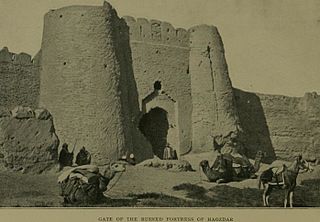Taj al-Din (died 1351) was the Mihrabanid malik of Sistan from 1346 until 1350. He was the son of Qutb al-Din Muhammad.
Malik, Melik, Malka, Malek, Malick, or Melekh is the Semitic term translating to "king", recorded in East Semitic and later Northwest Semitic and Arabic.

Sīstān, known in ancient times as Sakastan, is a historical and geographical region in present-day eastern Iran and southern Afghanistan.
Qutb al-Din Muhammad was the Mihrabanid malik of Sistan from 1330 until his death. He was the son of Rukn al-Din Mahmud.
Under his father, Taj al-Din had served as the governor of the town of Uq. After Qutb al-Din's death in 1346 he gained control of Sistan despite the rival claims of his first cousin once removed, Muhammad ibn Nusrat al-Din Muhammad. He was a well-intentioned but weak ruler, according to the sources [1] In 1350 he was forced out of Shahr-i Sistan by a conspiracy, which proceeded to enthrone Jalal al-Din Mahmud in his place.
Nusrat al-Din Muhammad was the Mihrabanid malik of Sistan from 1318 until his death. He was the son of Nasir al-Din Muhammad.

Zaranj or Zarang is a city in southwestern Afghanistan, near the border with Iran, which has a population of 160,902 people as of 2015. It is the capital of Nimruz province and is linked by highways with Lashkar Gah to the east, Farah to the north and the Iranian city of Zabol to the west. Zaranj is a major border crossing between Afghanistan and Iran, which is of significant importance to the trade-route between Central Asia and South Asia with the Middle East.
Jalal al-Din Mahmud was the Mihrabanid malik of Sistan from 1350 until his death. He was the son of Rukn al-Din Mahmud.
Taj al-Din did not abandon hope of recovering his position. Fleeing first to Kerman, he made his way to Herat and convinced the Kartid malik Mu'izz al-Din Husayn to support his cause. An army was assembled to restore Taj al-Din, but before it could march Herat was attacked by a coalition of tribes from the Chagatai Khanate under the command of the amir Qazaghan in 1351. Taj al-Din fought in the Kartid army to defend Herat but was killed.

Kerman is the capital city of Kerman Province, Iran. At the 2011 census, its population was 821,374, in 221,389 households, making it the 10th most populous city of Iran.

Herāt is the third-largest city of Afghanistan. It has a population of about 436,300, and serves as the capital of Herat Province, situated in the fertile valley of the Hari River in the western part of the country. It is linked with Kandahar, Kabul, and Mazar-i-Sharif via Highway 1 or the ring road. It is further linked to the city of Mashhad in neighboring Iran through the border town of Islam Qala, and to Mary in Turkmenistan to the north through the border town of Torghundi.

The Chagatai Khanate was a Mongol and later Turkicized khanate that comprised the lands ruled by Chagatai Khan, second son of Genghis Khan, and his descendants and successors. Initially it was a part of the Mongol Empire, but it became a functionally separate khanate with the fragmentation of the Mongol Empire after 1259. The Chagatai Khanate recognized the nominal supremacy of the Yuan dynasty in 1304, but became split into two parts in the mid-14th century: the Western Chagatai Khanate and the Moghulistan Khanate.


